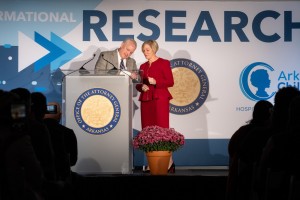Rural women are likely to face significant challenges finding secure and reliable employment following cancer treatment if they did not already have a secure job at the time of their diagnosis, according to a new study led by University of Arkansas for Medical Sciences (UAMS) researchers.
The study, which was published in the Journal of Cancer Survivorship, analyzed facilitators and barriers to employment for rural women who survived cancer and how benefits such as paid time off and a supportive work environment can help those women retain employment during and after treatment.
According to the National Cancer Institute (NCI), there are an estimated 17 million cancer survivors in the United States. Studies show that nearly half of the cancer survivors in the country are working age (between 20-64) at the time of their diagnosis.
"Employment offers important benefits, from financial stability to improved mental health, but many cancer survivors struggle to return to work or to work full-time after cancer treatment," said Emily Hallgren, PhD, with the UAMS Office of Community Health and Research. "Given the important benefits of work for individuals, families and society, it's important to understand what keeps cancer survivors from working after cancer treatment as well as what helps them succeed in the workforce."
Researchers interviewed women cancer survivors living in rural areas to determine benefits and challenges related to post-treatment employment.
Data showed that securely-employed participants who had full-time jobs with employment benefits such as paid time off and health insurance were more likely to retain their jobs through treatment. They also reported other informal benefits, such as flexible schedules, the ability to work from home and close relationships with co-workers and supervisors formed by a long period of employment.
Participants with insecure employment histories - such as part-time or temporary work, often without employment benefits - faced significantly more challenges returning full-time to the workforce. While some had paid sick time, they reported that it generally wasn't adequate enough for their treatment and recovery needs, and that other stressful job requirements made working through treatment more challenging. Other barriers to employment during and following cancer treatment included compromised immune systems, long-term treatment effects, limited job opportunities in rural areas, and stigma and discrimination.
"Some of our participants worked as babysitters or in schools, and their immune systems were at risk during and even after treatment," Hallgren said. "Without employment protections or accommodations, they had to leave their jobs. Others said they felt discriminated against in future job interviews, like their cancer diagnosis was seen as a burden or a liability."
Currently, the United States has two policies to protect employment for people diagnosed with disabling illnesses such as cancer: the Americans with Disabilities Act (ADA) and the Family Medical Leave Act (FMLA). However, those policies do not apply to temporary or informal workers or many small businesses, which may have a greater impact on rural survivors.
"Our findings highlight the need for robust supports for employees who are facing a serious illness, especially paid medical leave for all workers," Hallgren said. "And if someone does lose or leave their job during cancer treatment, they should be connected with job placement services if they want to return to work."
As advancements in cancer detection and treatment lead to greater chances of recovery, the NCI estimates that there will be more than 22 million cancer survivors in the country by 2030. More than two-thirds of cancer survivors now live five years or longer after diagnosis. For more information, visit cancer.gov.
Photo. Please see if you can find a woman at a job interview or something like that.











